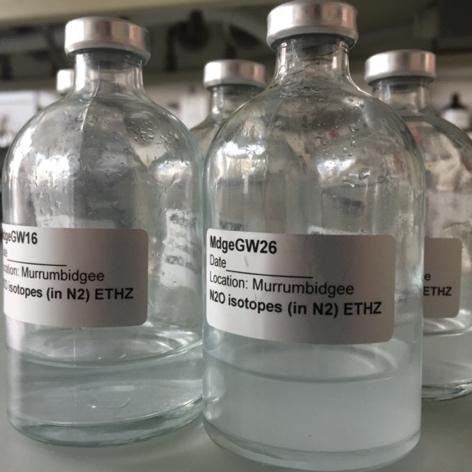N2O Isotope Lab
Our N2O isotope laboratory consists of one gas chromatograph (GC), two quantum cascade laser absorption spectroscopy (QCLAS) instruments, one trace gas extractor (TREX), and one isotope ratio mass spectrometer (IRMS).
The lab’s focus is to improve our understanding of N2O production and consumption processes in agricultural, forest, and aquatic ecosystems as the isotopic composition of N2O carries specific information that allows disentangling different sources and sinks of N2O. However, currently commercially available devices to measure N2O isotopic quantities of N2O require sophisticated calibration and workflow protocols to routinely measure accurately and precisely. Besides other reasons, this is due to (1) only recently available internationally certified N2O isotope standards (2) the low atmospheric abundance of N2O (a factor 1000 lower than CO2) and (3) method specific challenges such as mass overlap (IRMS) or spectral interference due to overlapping absorption lines (QCLAS). Therefore, our work also involves continued development to tackle the general measurement challenges in order to be accurate to draw correct ecological conclusions from the data and to be precise in order to resolve isotopic signatures of small fluxes.
QCLAS - Quantum Cascade Laser Absorption Spectroscopy
Laser spectroscopy allows real-time and site-specific monitoring of selected isotopocules (eg. 14N14N16O, 15N14N16O, 14N15N16O, and 14N14N18O) at concentrations at ambient levels through direct absorption based on their characteristic rotational-vibrational spectra. Our laboratory operates two dual quantum cascade laser instruments from Aerodyne Research Inc., one of which is coupled to a preconcentration device (TREX), while the second one is used to monitor real-time fluxes at the mesocosm facility (see mesocosm facility).
IRMS - Isotope Ratio Mass Spectrometry
Our laboratory operates an IRMS from Elementar (Isoprime100) consisting of seven Faraday cups with m/z of 28, 29, 30, 31, 44, 45 and 46 coupled to a gas preparation unit (Trace Gas, Elementar). Apart from bulk 15N and 18O in N2O, the instrument also quantifies 15N site preference indirectly through the measurement of NO+ created in the ion source during dissociation of N2O+, assuming that the N atom within the NO+ molecule represents the alpha position within the linear N2O molecule.
TREX – Trace Gas Extractor
The analytical performance of commercially available laser spectroscopy instruments is limited by (i) low ambient abundances of N2O isotopocules and (ii) due to spectral interferences of N2O isotopocules with other substances absorbing at the same wavelength region (e.g. carbon monoxide). To overcome these limitations, in collaboration with experts at the Empa Dübendorf, we are building an analytical device that is capable of pre-concentrating N2O from ambient air. At the same time, based on the principles of thermal separation, the device will allow standardizing the sample matrix, i.e. removal of interfering substances. With these adaptations, the performance of our laser spectrometers will be drastically improved.

Contact: Matti Barthel